Ephesus; Ancient Ephesus and the New Testament; Ephesus and Paul; Ephesus and Acts
Ancient Ephesus and the New Testament
by Rev. Dr. Mark D. Roberts
Copyright © 2007 by Mark D. Roberts
Note: You may download this resource at no cost, for personal use or for use in a Christian ministry, as long as you are not publishing it for sale. All I ask is that you give credit where credit is due. For all other uses, please contact me at mark@markdroberts.com. Thank you.
Ancient Ephesus and the New Testament: Introduction
Part 1 of series: Ancient Ephesus and the New Testament
Permalink for this post / Permalink for this series
For many of us, the events of the Bible seem to take place in some magic world of "Bible lands," a wonderland rather like the one discovered by Alice. We read about Jerusalem, Nazareth, Corinth, and Ephesus, but picture some hazy world shaped by illustrations in our children's Bibles. The places in which the stories of the Bible happened seem unreal, and so can the stories.
The more we actually know about the places in which the Bible was written, and in which the stories happened, the more we'll be able to read the Bible as it was meant to be read, as the account of real experiences by real people in real places. Moreover, we'll be able to understand the meaning of the Bible more accurately and precisely.
I've spent a great deal of my life studying the Bible from both an academic and a pastoral perspective. I've also examined in great detail many of the archeological descriptions of biblical sites. The Internet has made all of this much easier and quite wonderful, actually. (Check out sites such as http://www.holylandphotos.org/ and http://www.bibleplaces.com/). But, until this summer, I had visited only one place that could count as part of "Bible lands." In 1984, and again in 2004, I visited Rome, the city to which Paul's famous letter is addressed, and which is referenced in several New Testament passages. Strictly speaking, however, none of the biblical stories actually took place in Rome. (Photo to the right: The Areopagus [Mars Hill] from the Acropolis in Athens.)
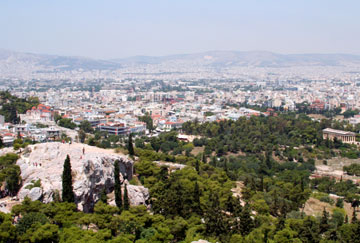 So you can imagine how excited I was to be able to visit two biblical sites this summer, Athens and Ephesus. Athens plays a minor role in the New Testament as the place where Paul preached his famous "sermon" on the Areopagus (Mars Hill). But Ephesus is arguably one of the most important of cities in early Christianity. Jerusalem probably takes first place in this competition, but Ephesus runs a close second. In the second century and beyond, of course, Rome became the most prominent city for Christianity. So you can imagine how excited I was to be able to visit two biblical sites this summer, Athens and Ephesus. Athens plays a minor role in the New Testament as the place where Paul preached his famous "sermon" on the Areopagus (Mars Hill). But Ephesus is arguably one of the most important of cities in early Christianity. Jerusalem probably takes first place in this competition, but Ephesus runs a close second. In the second century and beyond, of course, Rome became the most prominent city for Christianity.
Why was Ephesus so significant for early Christianity? In part, this had to do with the prominence of the city itself in the first century, and its central location along the coast of Asia Minor (modern day Turkey). But, more importantly, Ephesus attracted many influential Christian leaders, including Paul, John, Timothy, and others. (Ephesus claims to be the last place where Mary, the mother of Jesus, lived, though the historical evidence for this is mixed at best.)
Prior to my visit to Ephesus, I had studied this city in great detail. It almost felt as if I had been there. So you can imagine my joy in actually seeing the extensive remains of the ancient city of Ephesus with my own eyes. This was in spite of the fact that it was well over 100 degrees on the day we visited, and there is almost no shade in the ancient city.
In the posts that follow I'll share some of my pictures of Ephesus, and explain how our knowledge of actual city enriches our understanding of the New Testament, especially Acts 18-19. If you've been to Ephesus, this can serve as a helpful reminder. If you've never been there, consider this an introduction and invitation.
The Location and Environment of Ephesus
Part 2 of series: Ancient Ephesus and the New Testament
Permalink for this post / Permalink for this series
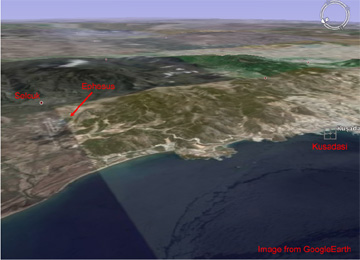 Ephesus, or what is left of it, lies on the western edge of modern day Turkey, just about five miles inland from the Aegean coast. The picture to the right shows the location of Ephesus. It is close to the modern town of Selcuk. Most tourists visit Ephesus by way of the port city of Kusadasi, which is about a 45-minute drive from Ephesus. The countryside between these two cities is fertile, lush with agriculture. It reminded me of farmlands inland from San Diego, California. Ephesus, or what is left of it, lies on the western edge of modern day Turkey, just about five miles inland from the Aegean coast. The picture to the right shows the location of Ephesus. It is close to the modern town of Selcuk. Most tourists visit Ephesus by way of the port city of Kusadasi, which is about a 45-minute drive from Ephesus. The countryside between these two cities is fertile, lush with agriculture. It reminded me of farmlands inland from San Diego, California.
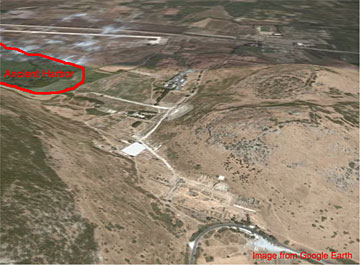 Given the current location of Ephesus, you might be surprised to learn that it was once a major port city. No, Ephesus didn't move, or not much, anyway. Ancient cities did tend to move around a bit. When a city burned down, they'd rebuild it nearby. Ephesus was no exception. But it wasn't a change of location that made Ephesus a port city. Rather, it was the changing shoreline. In ancient times, Ephesus had a harbor, such that the city went right up to the water. But sediment from the Cayster River eventually filled in the harbor. (The photo to the right shows the location of the ancient harbor.) Given the current location of Ephesus, you might be surprised to learn that it was once a major port city. No, Ephesus didn't move, or not much, anyway. Ancient cities did tend to move around a bit. When a city burned down, they'd rebuild it nearby. Ephesus was no exception. But it wasn't a change of location that made Ephesus a port city. Rather, it was the changing shoreline. In ancient times, Ephesus had a harbor, such that the city went right up to the water. But sediment from the Cayster River eventually filled in the harbor. (The photo to the right shows the location of the ancient harbor.)
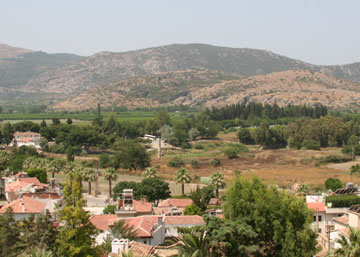 Ephesus itself lies in a valley. It is protected by steep hills on either side. In days gone by, this would have helped to guard the city from enemy attack. The valley also adds to the beauty of the location, even today. (In the photo to the right, Ephesus lies on the other side of the two low hills in the middle of the picture, and at the bottom of the larger hill in the background.) Ephesus itself lies in a valley. It is protected by steep hills on either side. In days gone by, this would have helped to guard the city from enemy attack. The valley also adds to the beauty of the location, even today. (In the photo to the right, Ephesus lies on the other side of the two low hills in the middle of the picture, and at the bottom of the larger hill in the background.)
One of the most famous of Ephesus's ancient structures, the Temple of Artemis, was not located in the center of the city as it was found in Roman times. Rather, the Artemision was a mile or so out of town. All that remains of the temple is a single pillar, which lies just to the left of the center of the picture to the right.
Tomorrow I'll talk about tours of Ephesus and start in on my online photo tour.
Touring Ancient Ephesus
Part 3 of series: Ancient Ephesus and the New Testament
Permalink for this post / Permalink for this series
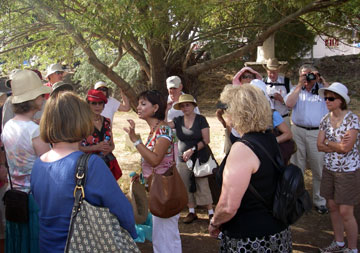 In late June I took a tour of Ephesus. It lasted about two hours, and was quite informative. Our tour guide, a Turkish woman (in center of picture to the right) really knew her stuff. It turns out she had studied archeology in grad school, and had even participated in some of the digs at Ephesus. She only got one thing a little wrong, from my point of view. The so-called "brothel" in Ephesus was not, in all likelihood, a brothel so much as a boarding house. But the brothel story is much more interesting. (If you're looking for a real ancient brothel, try Pompeii. Seriously. The wall frescoes are x-rated.) In late June I took a tour of Ephesus. It lasted about two hours, and was quite informative. Our tour guide, a Turkish woman (in center of picture to the right) really knew her stuff. It turns out she had studied archeology in grad school, and had even participated in some of the digs at Ephesus. She only got one thing a little wrong, from my point of view. The so-called "brothel" in Ephesus was not, in all likelihood, a brothel so much as a boarding house. But the brothel story is much more interesting. (If you're looking for a real ancient brothel, try Pompeii. Seriously. The wall frescoes are x-rated.)
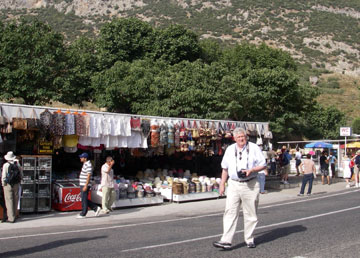 The valley in which Ephesus lies slopes toward the sea. Therefore tours of the city tend to start at the eastern end and work toward the west, which means tourists can walk downhill rather than up. This is helpful in the summer especially, when the temperatures can be quite steamy. When we were in Ephesus, the thermometer was well over 100 degrees Fahrenheit, and there is almost no shade available among the ruins. The valley in which Ephesus lies slopes toward the sea. Therefore tours of the city tend to start at the eastern end and work toward the west, which means tourists can walk downhill rather than up. This is helpful in the summer especially, when the temperatures can be quite steamy. When we were in Ephesus, the thermometer was well over 100 degrees Fahrenheit, and there is almost no shade available among the ruins.
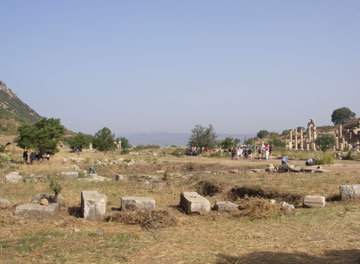 Near the eastern entrance to ancient Ephesus you'll find plenty of vendors, some of them literally sticking their wares into your face, only a couple of inches from your nose. You can buy clothing, hats (recommended for the tour if it's hot and sunny), soft drinks, and various souvenirs. Don't bother with the supposedly authentic old coins. They're neither authentic nor old. Near the eastern entrance to ancient Ephesus you'll find plenty of vendors, some of them literally sticking their wares into your face, only a couple of inches from your nose. You can buy clothing, hats (recommended for the tour if it's hot and sunny), soft drinks, and various souvenirs. Don't bother with the supposedly authentic old coins. They're neither authentic nor old.
The beginning of the tour of Ephesus is relatively unimpressive. For the most part, you see dozens of stones, obviously part of ancient buildings. But you won't see any restored ruins, except in the distance. Almost all of what makes Ephesus so special lies out of view, down the slope of the valley.
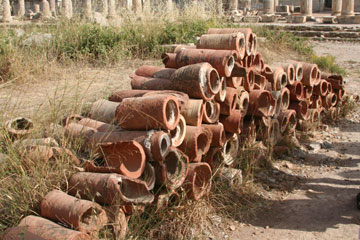 Near the beginning of the tour there was a stack of what looked like pieces of terra cotta pipe. Indeed, these sections of pipe were once part of the elaborate fresh water system for Ephesus. The Romans, who were masters of moving water around, had build aqueducts that brought water to the city. Then large pipes, pieces of which you can see in the photo to the right, moved the water around to key locations of the city (the baths, fountains, men's toilet, etc.). Near the beginning of the tour there was a stack of what looked like pieces of terra cotta pipe. Indeed, these sections of pipe were once part of the elaborate fresh water system for Ephesus. The Romans, who were masters of moving water around, had build aqueducts that brought water to the city. Then large pipes, pieces of which you can see in the photo to the right, moved the water around to key locations of the city (the baths, fountains, men's toilet, etc.).
Tomorrow the tour continues.
Touring Ancient Ephesus, Part 2
Part 4 of series: Ancient Ephesus and the New Testament
Permalink for this post / Permalink for this series
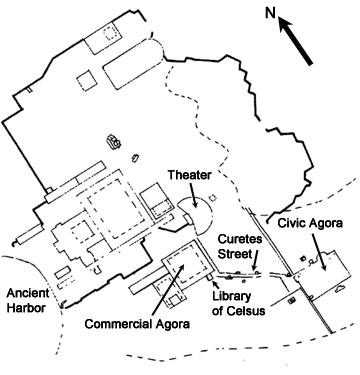 A tour of Ephesus usually begins, as I explained yesterday, at the eastern end of the city because from the you walk downhill rather than uphill. In the map to the right you can see several of the major features of the ancient Ephesus, including the two agoras, the theatre, and the Library of Celsus. When you're walking through Ephesus today, it seems small, like a town that might have had 5,000 residents. In fact ancient Ephesus had perhaps as many as 200,000 residents. Many of their homes have not been excavated or refurbished. But even with all the original structures intact, a person today would be impressed by the extent to which people were crowded together in this city, as in others throughout the Roman Empire. A tour of Ephesus usually begins, as I explained yesterday, at the eastern end of the city because from the you walk downhill rather than uphill. In the map to the right you can see several of the major features of the ancient Ephesus, including the two agoras, the theatre, and the Library of Celsus. When you're walking through Ephesus today, it seems small, like a town that might have had 5,000 residents. In fact ancient Ephesus had perhaps as many as 200,000 residents. Many of their homes have not been excavated or refurbished. But even with all the original structures intact, a person today would be impressed by the extent to which people were crowded together in this city, as in others throughout the Roman Empire.
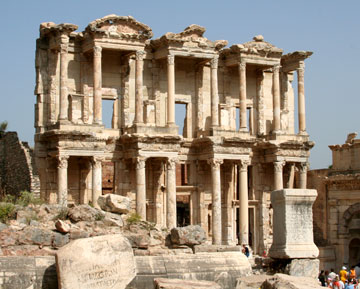 The Library of Celsus is perhaps the beautiful of the restored buildings in Ephesus, and is often the place of evening concerts and other festivities. This library, which was once one of the largest in the ancient world, was not built during the first century AD, the time of greatest interest for New Testament scholars. It was constructed in AD 135 by a man who built it in honor of his father, Celsus, who had been a governor of Asia Minor (the location of Ephesus in the Roman Empire). Today, the library consists of a rebuilt façade, without the rooms that once contained thousands of scrolls. The Library of Celsus is perhaps the beautiful of the restored buildings in Ephesus, and is often the place of evening concerts and other festivities. This library, which was once one of the largest in the ancient world, was not built during the first century AD, the time of greatest interest for New Testament scholars. It was constructed in AD 135 by a man who built it in honor of his father, Celsus, who had been a governor of Asia Minor (the location of Ephesus in the Roman Empire). Today, the library consists of a rebuilt façade, without the rooms that once contained thousands of scrolls.
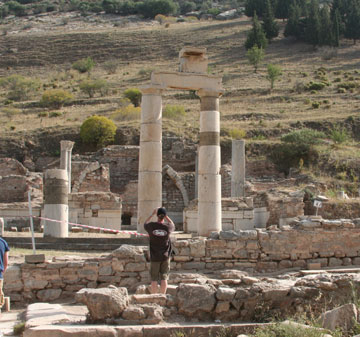 If your tour begins in the eastern end of Ephesus, you first walk into one of the two agoras (or marketplaces) of the ancient city. There's not much left of this civic agora, the place where the official business of Ephesus was once conducted. One of the buildings alongside the civic agora was the Prytaneion. This building was the center of city business. It was dedicated to the goddess Hestia, and contained the city's sacred flame that was never allowed to go out. There is not much left of the Prytaneion, apart from a couple of rebuilt pillars. It was in this location that two statues of the goddess Artemis were discovered. They are now found in the Ephesus museum. I'll have more to say about them later. If your tour begins in the eastern end of Ephesus, you first walk into one of the two agoras (or marketplaces) of the ancient city. There's not much left of this civic agora, the place where the official business of Ephesus was once conducted. One of the buildings alongside the civic agora was the Prytaneion. This building was the center of city business. It was dedicated to the goddess Hestia, and contained the city's sacred flame that was never allowed to go out. There is not much left of the Prytaneion, apart from a couple of rebuilt pillars. It was in this location that two statues of the goddess Artemis were discovered. They are now found in the Ephesus museum. I'll have more to say about them later.
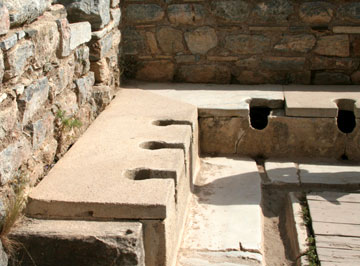 One of the highlights of the Ephesus tour is the men's toilet, found along Curetes Street. This bathroom, as we'd say in the USA, once contained about twenty places for me to do their business. It had a running water sewage system in its day. Perhaps the most surprising part of this bathroom is that the seats were placed very few inches apart, without any barriers. So a man might find himself sitting next to another man, almost touching as they used the facilities. Apparently, men used this as a place to socialize. There certainly wasn't much privacy, that's for sure. One of the highlights of the Ephesus tour is the men's toilet, found along Curetes Street. This bathroom, as we'd say in the USA, once contained about twenty places for me to do their business. It had a running water sewage system in its day. Perhaps the most surprising part of this bathroom is that the seats were placed very few inches apart, without any barriers. So a man might find himself sitting next to another man, almost touching as they used the facilities. Apparently, men used this as a place to socialize. There certainly wasn't much privacy, that's for sure.
Rather than continue this blog "tour" of Ephesus, I'm going to change gears in my next post and begin to make connections between the New Testament and the ancient city.
Ephesus in the New Testament
Part 5 of series: Ancient Ephesus and the New Testament
Permalink for this post / Permalink for this series
Early Christianity was significantly an urban movement. This might sound surprising if you're used to thinking of Christians continuing the mode of Jesus, whose ministry happened largely (but not only) in rural Galilee. Yet when we pay close attention to the facts of Christianity in the first-century A.D., we see the prominence of cities, including Jerusalem, Antioch (in Syria), Corinth, Rome, and Ephesus.
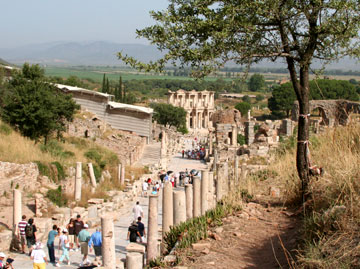 Arguably, Ephesus was the most important city for Christians at the end of the first century. Jerusalem had pride of place at first. Rome was growing in influence in the early second century. But, not only was Ephesus situated rather in the center of an area in which Christianity was thriving, but also it was an important city in its own right, and a place associated with several prominent Christians, including Paul, Timothy, John, and perhaps even the Virgin Mary. (People who live near Ephesus, along with many Roman Catholics throughout the world, believe that Mary lived just outside of Ephesus during her last days on earth. The photo to the right shows the center of Ephesus today, Curetes Street with the Library of Celsus in the distance.) Arguably, Ephesus was the most important city for Christians at the end of the first century. Jerusalem had pride of place at first. Rome was growing in influence in the early second century. But, not only was Ephesus situated rather in the center of an area in which Christianity was thriving, but also it was an important city in its own right, and a place associated with several prominent Christians, including Paul, Timothy, John, and perhaps even the Virgin Mary. (People who live near Ephesus, along with many Roman Catholics throughout the world, believe that Mary lived just outside of Ephesus during her last days on earth. The photo to the right shows the center of Ephesus today, Curetes Street with the Library of Celsus in the distance.)
The fact that Christianity was primarily an urban movement helps to explain its rapid spread throughout the Roman world. Cities were the hubs of travel, trade, and culture. If one influenced a major city in a region, then one would also be able to influence the whole region.
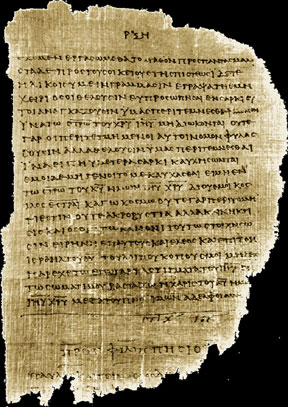 When we think of Ephesus and the New Testament, most of us would at first remember the letter of Paul called "The Letter to the Ephesians" or, simply, "Ephesians." But it turns out that the connection between this letter and Ephesus is rather uncertain. Some of the earliest manuscripts of the letter do not contain the words "in Ephesus" (en Epheso). For example, Papyrus 46, one of the oldest and most reliable manuscripts of Paul's letters, does not mention Ephesus. (The picture to the right shows part of this manuscript.) Many scholars believe that the so-called Letter to the Ephesians was originally a circular letter intended for several churches, including the church in Ephesus. This many also explain why the letter has so little in it that is identifiably Ephesian. When we think of Ephesus and the New Testament, most of us would at first remember the letter of Paul called "The Letter to the Ephesians" or, simply, "Ephesians." But it turns out that the connection between this letter and Ephesus is rather uncertain. Some of the earliest manuscripts of the letter do not contain the words "in Ephesus" (en Epheso). For example, Papyrus 46, one of the oldest and most reliable manuscripts of Paul's letters, does not mention Ephesus. (The picture to the right shows part of this manuscript.) Many scholars believe that the so-called Letter to the Ephesians was originally a circular letter intended for several churches, including the church in Ephesus. This many also explain why the letter has so little in it that is identifiably Ephesian.
The oldest references to Ephesus in the New Testament are found in Paul's First Letter to the Corinthians. There he writes:
If with merely human hopes I fought with wild animals at Ephesus, what would I have gained by it? (1 Cor 15:32)
I do not want to see you now just in passing, for I hope to spend some time with you, if the Lord permits. But I will stay in Ephesus until Pentecost, for a wide door for effective work has opened to me, and there are many adversaries. (1 Cor 16:7-9)
Unfortunately, we don't know exactly what Paul means by fighting wild animals at Ephesus. The Ephesians were enthusiastic for games in which African animals fought against animals or people. But it seems most likely that Paul is speaking metaphorically, referring to some conflict that he had in Ephesus. Nevertheless, it does seem obvious that Paul was writing the letter we know as 1 Corinthians from Ephesus, where he was engaged in missionary work for an extended period of time. It was during this time that he must have "fought with wild animals." Perhaps Paul was referring to the conflict we read about in Acts 19. I'll turn to this in my next post.
The Apostle Paul in Ephesus
Part 6 of series: Ancient Ephesus and the New Testament
Permalink for this post / Permalink for this series
In my last post I quoted a passage from Paul's first letter to the Corinthians in which he wrote, "But I will stay in Ephesus until Pentecost, for a wide door for effective work has opened to me, and there are many adversaries" (1 Cor 16:8-9). This fits perfectly with the picture painted of Paul's Ephesian ministry in Acts of the Apostles.
In Acts 18, Paul visited Ephesus briefly on his trip from Corinth back to Jerusalem (18:18-22). Verse 24 introduces a Jewish teacher named Apollos, who taught in the synagogue in Ephesus. This synagogue hasn't been located by archeologists. Apollos accurately passed on some truths about Jesus, but didn't know the whole story. So a leading Christian couple, Priscilla and Aquila, taught Apollos the what he had been missing. More fully informed, Apollos journeyed on to Corinth.
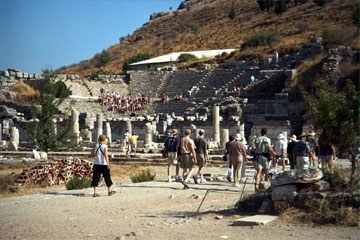 Acts 19 begins with Paul's appearance at Ephesus. First, he laid hands on some disciples who received the Holy Spirit with power (19:1-7). Next, he presented the message of the kingdom of God in the Jewish synagogue, arguing persuasively. But when most of the Jews were closed to Paul's message, he moved to the lecture hall of Tyrannus, where he continued preaching for two years. Today we do not know exactly the location of this lecture hall. In all likelihood it was a place where the men of Ephesus gathered for lectures on various subjects, including philosophy and religion. Ephesus was well known in the ancient world as a place of learning, and Paul would have been seen as one more philosopher with a tempting message offering transformation and immortality. (The photo to the right shows the Odeum in Ephesus, a theatre that could seat more than 1,000 people. Public lectures were given here. This was also the place where the city business was done. Photo from http://www.holylandphotos.org/.) Acts 19 begins with Paul's appearance at Ephesus. First, he laid hands on some disciples who received the Holy Spirit with power (19:1-7). Next, he presented the message of the kingdom of God in the Jewish synagogue, arguing persuasively. But when most of the Jews were closed to Paul's message, he moved to the lecture hall of Tyrannus, where he continued preaching for two years. Today we do not know exactly the location of this lecture hall. In all likelihood it was a place where the men of Ephesus gathered for lectures on various subjects, including philosophy and religion. Ephesus was well known in the ancient world as a place of learning, and Paul would have been seen as one more philosopher with a tempting message offering transformation and immortality. (The photo to the right shows the Odeum in Ephesus, a theatre that could seat more than 1,000 people. Public lectures were given here. This was also the place where the city business was done. Photo from http://www.holylandphotos.org/.)
Paul's ministry flourished, in part because of the power of God that brought healing and deliverance from demonic oppression. Many Ephesians who had been enamored with magical practices (what we'd call dark magic, not stage magic) renounced these practices and publicly burned their books of magic.
This sounds innocuous enough to us, but it doesn't take too much imagination to see how the success of Paul's ministry led to trouble. Magic and superstition permeated Ephesian culture, so that the burning of magic books would have seemed antisocial. It would be rather like if a whole bunch of people in my city got together and burned their PDAs, Daytimers, and cell phones. Moreover, the people who wrote, bought, and sold books of magic would rightly have perceived an economic threat from Paul and those influenced by him.
This latter issue, the economic danger posed by Paul, in fact led to a major brouhaha in Ephesus. I'll examine this more closely in my next post.
Artemis and Her Temple
Part 7 of series: Ancient Ephesus and the New Testament
Permalink for this post / Permalink for this series
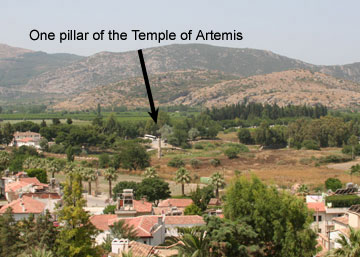 In my last post I summarized the beginning of Paul's ministry in Ephesus as it's described in Acts 19. We saw that after first being stymied in his effort to reach out to Ephesian Jews through the synagogue, Paul switched to a lecture hall, where he experienced a more positive response to his preaching. In fact, the success of Paul's ministry led to a major disturbance in the city. In order to grasp the nature of this uproar, we must understand one of the most important facts about ancient Ephesus: it was home to the Temple of Artemis. In my last post I summarized the beginning of Paul's ministry in Ephesus as it's described in Acts 19. We saw that after first being stymied in his effort to reach out to Ephesian Jews through the synagogue, Paul switched to a lecture hall, where he experienced a more positive response to his preaching. In fact, the success of Paul's ministry led to a major disturbance in the city. In order to grasp the nature of this uproar, we must understand one of the most important facts about ancient Ephesus: it was home to the Temple of Artemis.
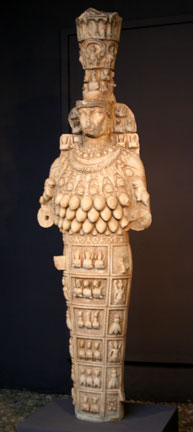 Ironically, this temple has been mentioned in recent news stories (click here for an example). Late last month a survey of 100 million voters resulted in a new list of the Seven Wonders of the World. In its current state, the Temple of Artemis would never make such a list. But in its heyday, which includes the first century A.D., this temple was considered one of the Seven Wonders of the World. It was one of the largest temples in the world, and drew visitors from far and wide. Ironically, this temple has been mentioned in recent news stories (click here for an example). Late last month a survey of 100 million voters resulted in a new list of the Seven Wonders of the World. In its current state, the Temple of Artemis would never make such a list. But in its heyday, which includes the first century A.D., this temple was considered one of the Seven Wonders of the World. It was one of the largest temples in the world, and drew visitors from far and wide.
The goddess Artemis was a combination of the Greek goddess named Artemis, the virginal goddess of the hunt. In Asia Minor, the region of Ephesus, this Greek goddess was combined with elements associated with the Anatolian goddess Cybele, who was associated the earth and with fertility, and was sometimes known as the Great Mother. (Yes, the Ephesian Artemis somehow combined the virginal Artemis with Cybele, the fertile mother. The photo to the right shows a statue of Artemis that was found at Ephesus, and is now prominently displayed in the Ephesian museum. The "crown" on her head is a representation of the temple. The "eggs" surrounding her midsection are perhaps some fertility symbol, though scholars don't agree on their denotation.)
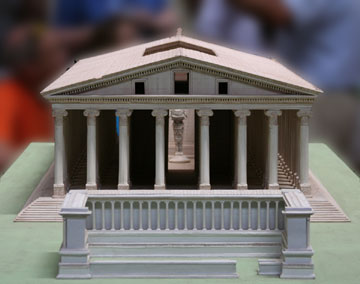 For Ephesus, having the temple of Artemis nearby (about a mile from the main city) was a great boon. One the one hand, the presence of such a temple demonstrated the importance of Ephesus and was thought to bring special blessing upon the city. On the other hand, worshipers came from all around to visit the temple, and in so doing spent lots of money on lodging, offerings, and so forth. For Ephesus, having the temple of Artemis nearby (about a mile from the main city) was a great boon. One the one hand, the presence of such a temple demonstrated the importance of Ephesus and was thought to bring special blessing upon the city. On the other hand, worshipers came from all around to visit the temple, and in so doing spent lots of money on lodging, offerings, and so forth.
Today, little is left of the temple of Artemis. You must use your imagination to picture its former glory. There is, however, a model of the temple in the museum which can help to fill in the blanks.
Therefore, anything that threatened the prominence of Artemis and her temple would have been seen as a major threat to Ephesus itself. In my next post we'll see how this played out in Acts 19.
Paul and the Silversmiths
Part 8 of series: Ancient Ephesus and the New Testament
Permalink for this post / Permalink for this series
Now that we know something about the goddess Artemis and her importance for Ephesus, we're ready to get back to the story of Paul's ministry in this city.
As Paul's ministry began to thrive in Ephesus, a certain Demetrius became concerned. He was a silversmith who made little pieces of jewelry in the image of the goddess Artemis or, as most scholars think, of her temple. These were not souvenirs that worshipers took home with them, but rather small offerings given to the goddess when they visited her temple. Demetrius, noting the growing impact of Paul's ministry, gathered the other silversmiths together and presented his case:
“Men, you know that we get our wealth from this business. You also see and hear that not only in Ephesus but in almost the whole of Asia this Paul has persuaded and drawn away a considerable number of people by saying that gods made with hands are not gods. And there is danger not only that this trade of ours may come into disrepute but also that the temple of the great goddess Artemis will be scorned, and she will be deprived of her majesty that brought all Asia and the world to worship her.” (Acts 19:25-27)
Notice that Demetrius was worried, first of all, about the potential loss of income if too many people become Christians. Second, he was worried about the loss of glory for Artemis.
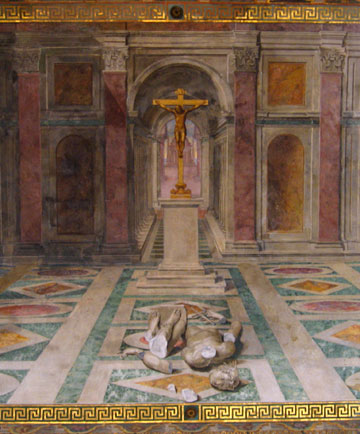 Demetrius understood something essential about Christianity, something that reflected accurate insight. He knew that when people become Christians, they stop worshiping pagan gods. While we might assume this to be true, nobody in Ephesus would have done so (besides the Jews, who were vigorous monotheists). It was very common in the ancient world for people to add new gods to their personal pantheon. It was uncommon for them to insist that there was only one true God. If Paul had offered up Jesus, not as the only Savior of the world, but simply as one more savior among many, then the Ephesians would probably have built a temple to Jesus and included him in their pagan celebrations. But Christianity was distinctive, unsettling so, from an Ephesian point of view, in that it claimed the total allegiance of followers. Thus Demetrius rightly concluded that the success of Christianity would lead to the demise of Artemis worship. (That this very thing ultimately happened in the Roman Empire is celebrated on one of the ceiling frescoes in the Vatican. Tommaso Laureti, painting in the late 16th century, represented the "Triumph of Christianity" with a shattered statue of a god before the cross of Christ.) Demetrius understood something essential about Christianity, something that reflected accurate insight. He knew that when people become Christians, they stop worshiping pagan gods. While we might assume this to be true, nobody in Ephesus would have done so (besides the Jews, who were vigorous monotheists). It was very common in the ancient world for people to add new gods to their personal pantheon. It was uncommon for them to insist that there was only one true God. If Paul had offered up Jesus, not as the only Savior of the world, but simply as one more savior among many, then the Ephesians would probably have built a temple to Jesus and included him in their pagan celebrations. But Christianity was distinctive, unsettling so, from an Ephesian point of view, in that it claimed the total allegiance of followers. Thus Demetrius rightly concluded that the success of Christianity would lead to the demise of Artemis worship. (That this very thing ultimately happened in the Roman Empire is celebrated on one of the ceiling frescoes in the Vatican. Tommaso Laureti, painting in the late 16th century, represented the "Triumph of Christianity" with a shattered statue of a god before the cross of Christ.)
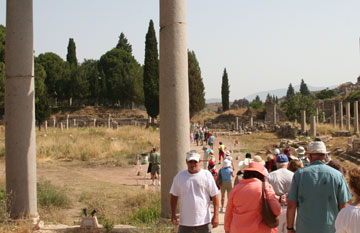 Though Acts doesn't tell us exactly where Demetrius made his speech, it most likely happened within the commercial agora (or marketplace), that is adjacent to the Library of Celsus. This large space is quite open today, but once would have been surrounded by colonnades, under which merchants and craftsmen sold their goods. Though Acts doesn't tell us exactly where Demetrius made his speech, it most likely happened within the commercial agora (or marketplace), that is adjacent to the Library of Celsus. This large space is quite open today, but once would have been surrounded by colonnades, under which merchants and craftsmen sold their goods.
Demetrius's effort was successful. 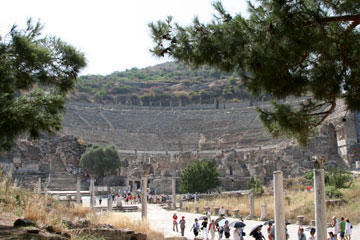 The enraged silversmith's began shouting praises to Artemis. They grabbed some of Paul's companions and dragged them to the theater. This theater, much of which is still intact, is an impressive structure even today. It could contain up to 25,000 people. Folks sitting in the "cheap seats" would have had an impressive view of the harbor (now just a marshy area). According to Acts, Paul wanted to go to the theatre, no doubt to defend his friends. But some Christians and even some of the city officials convinced Paul that this would not be wise. The enraged silversmith's began shouting praises to Artemis. They grabbed some of Paul's companions and dragged them to the theater. This theater, much of which is still intact, is an impressive structure even today. It could contain up to 25,000 people. Folks sitting in the "cheap seats" would have had an impressive view of the harbor (now just a marshy area). According to Acts, Paul wanted to go to the theatre, no doubt to defend his friends. But some Christians and even some of the city officials convinced Paul that this would not be wise.
I'll finish up the story of Paul and the silversmiths in my next post in this series.
Paul and the Silversmiths, Part 2
Part 9 of series: Ancient Ephesus and the New Testament
Permalink for this post / Permalink for this series
When we last left our series on Ancient Ephesus and the New Testament, the city was in an uproar. A gang of silversmiths, at the instigation of a certain Demetrius, were rioting, dragging several of Paul's colleagues to the theater. When Paul tried to go to the theater, he was dissuaded by some of other Christians and even some civic officials. It simply wasn't safe for Paul to show up in such a chaotic and dangerous environment.
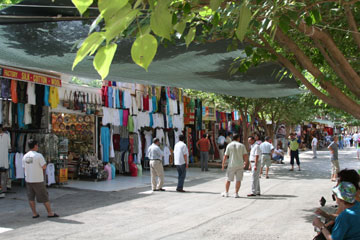 The description in Acts 19 of the mob in the theater is ironic, though in a way not immediately recognizable in English. It reads: "Meanwhile, some were shouting one thing, some another; for the assembly was in confusion, and most of them did not know why they had come together" (v. 32). Even in English one can see the humor in that most in the mob didn't even know why they were there. But the word translated here as "assembly" is, in Greek, ekklesia. As you may know, this word is usually translated as "church" in the New Testament. In secular Greek, ekklesia meant assembly of people, but unusually stood for the orderly gathering of citizens of a given city. So ekklesia in Acts 19:32 is doubly ironic, in that the mob surely isn't a church, and it surely isn't orderly. (Photo above: I didn't see any silversmiths in the souvenir market near the Ephesians theater. I was impressed, however, by the sign below.) The description in Acts 19 of the mob in the theater is ironic, though in a way not immediately recognizable in English. It reads: "Meanwhile, some were shouting one thing, some another; for the assembly was in confusion, and most of them did not know why they had come together" (v. 32). Even in English one can see the humor in that most in the mob didn't even know why they were there. But the word translated here as "assembly" is, in Greek, ekklesia. As you may know, this word is usually translated as "church" in the New Testament. In secular Greek, ekklesia meant assembly of people, but unusually stood for the orderly gathering of citizens of a given city. So ekklesia in Acts 19:32 is doubly ironic, in that the mob surely isn't a church, and it surely isn't orderly. (Photo above: I didn't see any silversmiths in the souvenir market near the Ephesians theater. I was impressed, however, by the sign below.)
 At some point during the fracas a Jew named Alexander tried to speak. Though we don't know why he did this, it's most likely he was going to put some distance between the Jews of Ephesus and Paul. But Alexander was shouted down while the mob chanted: "Great is Artemis of the Ephesians!" for a couple of hours. At some point during the fracas a Jew named Alexander tried to speak. Though we don't know why he did this, it's most likely he was going to put some distance between the Jews of Ephesus and Paul. But Alexander was shouted down while the mob chanted: "Great is Artemis of the Ephesians!" for a couple of hours.
Finally, the town clerk (more like the mayor than the office manager), got the people quiet. He made a diplomatic speech, reassuring the crowd that Paul and company were "neither temple robbers nor blasphemers of our goddess" (v. 37). If Demetrius had a complaint, he should bring that up in an orderly way, through the courts or the proconsuls. The clerk closed by saying, "If there is anything further you want to know, it must be settled in the regular assembly" (v. 39). Here, once again, we find the use of ekklesia, now in the Greek expression en tei ennomoi ekklesiai ("in the lawful assembly").
Why would the clerk have spoken in Paul's defense, especially since it seems likely that he was a worshiper of Artemis? The answer comes in verse 40: "For we are in danger of being charged with rioting today, since there is no cause that we can give to justify this commotion." Who would charge the Ephesians with rioting? The Romans. And the Romans didn't ignore civic unrest because they knew it could easily turn against them. If the Ephesians were to allow a riot, Rome might very well clamp down on Ephesian freedoms and authority. No matter what the clerk actually thought of Paul and the Christians, he was eager to keep the peace. And, according to Acts 19, in this he was ultimately successful.
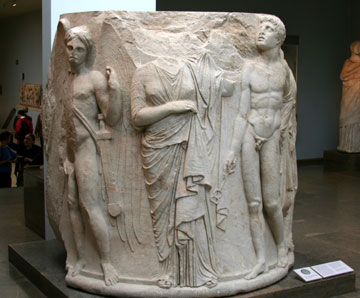 What Demetrius feared ultimately came to pass, though not only because of the growth of Christianity. In time, the worship of Artemis began to fade, and her famed temple lost its glory. Today, you can see more interesting remnants of the Ephesian Artemision in the British Museum in London than in Ephesus itself. But this is not to say that Christianity is dominant in Ephesus and environs. Turkey is predominantly a Muslim country today, though most Turks are secular in their orientation. And the most prominent church in the area, very near the Artemision, is itself in ruins. Christian activity around Ephesus is mostly centered in a small house that is supposedly the place from which the Virgin Mary was taken to heaven. I'll say a bit more about this next time. (The photo above is from the British Museum. It shows a decorative part of one of the pillars from the Ephesian Artemision.) What Demetrius feared ultimately came to pass, though not only because of the growth of Christianity. In time, the worship of Artemis began to fade, and her famed temple lost its glory. Today, you can see more interesting remnants of the Ephesian Artemision in the British Museum in London than in Ephesus itself. But this is not to say that Christianity is dominant in Ephesus and environs. Turkey is predominantly a Muslim country today, though most Turks are secular in their orientation. And the most prominent church in the area, very near the Artemision, is itself in ruins. Christian activity around Ephesus is mostly centered in a small house that is supposedly the place from which the Virgin Mary was taken to heaven. I'll say a bit more about this next time. (The photo above is from the British Museum. It shows a decorative part of one of the pillars from the Ephesian Artemision.)
The House of the Virgin Mary?
Part 10 of series: Ancient Ephesus and the New Testament
Permalink for this post / Permalink for this series
Until recently, I have never given much thought to what happened to Mary, the mother of Jesus, after His death. I figured that she went to Jerusalem, where James, one of her other sons (or stepsons, if you prefer), was a prominent early Christian leader. A good bit of ancient tradition supports this hunch, as it turns out. (See, for example, the online Catholic Encyclopedia article on "The Blessed Virgin Mary.")
It's curious that Mary received little special attention among the early Christians. In fact, her life after Jesus's death remains largely a mystery. But, I learned earlier this summer, many people believe that Mary spent her last days near Ephesus, and that's where she died (or was taken up to heaven).
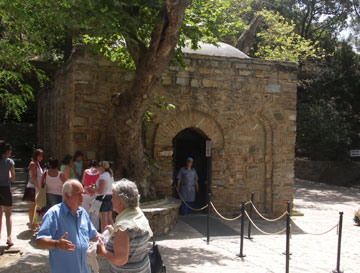 Most tours of ancient Ephesus include a side trip to the so-called House of the Virgin Mary. This sacred site lies several miles south of Ephesus, up on the top of a mountain. Unlike barren Ephesus, Mary's house is hidden in a forest, where the temperatures are several degrees cooler and shade in ample. (The photo to the right shows part of Mary's House.) Most tours of ancient Ephesus include a side trip to the so-called House of the Virgin Mary. This sacred site lies several miles south of Ephesus, up on the top of a mountain. Unlike barren Ephesus, Mary's house is hidden in a forest, where the temperatures are several degrees cooler and shade in ample. (The photo to the right shows part of Mary's House.)
The evidence for Mary having spent her last days here is circumstantial and supernatural. The circumstantial evidence is this:
• Shortly before His death, Jesus entrusted His mother to the care of the Beloved Disciple (John 19:26-27).
• Christian tradition holds that the Beloved Disciple was John.
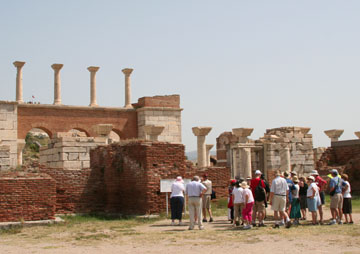 • Christian tradition also associates John with Ephesus, where he supposedly spent the latter part of his life. It is believed that he was buried there, and that his body used to lie under the Basilica of St. John (now in ruins, as you can see in the photo to the right). • Christian tradition also associates John with Ephesus, where he supposedly spent the latter part of his life. It is believed that he was buried there, and that his body used to lie under the Basilica of St. John (now in ruins, as you can see in the photo to the right).
• It is possible that John took Mary with him to Ephesus, perhaps because Jerusalem in the late first century A.D. was not hospitable for the mother of the controversial Messiah.
The supernatural evidence is this:
• Early in the 19th century, a German nun named Anne Catherine Emmerich claimed to have visions. Among these, she "saw" the house of the Virgin Mary, and described it in great detail. Her visions were ultimately published, and near the end of the 19th century a Catholic research team found the site described by Emmerich, though she had never seen it in person. (Emmerich's writings on the death of Jesus had a profound influence on Mel Gibson and his The Passion of the Christ.)
Catholic tradition is divided on the final residence of Mary, though several popes have endorsed Mary's House as a religious shrine. Less than a year ago, Pope Benedict XVI visited the site, honoring it with his presence and words, though not definitively declaring it to be Mary's house.
The actual building on the site are not old enough to have been the actual dwelling of Mary. But it's certainly possible that they were built in the place and design of the original buildings. A Turkish website has several Quicktime videos that allow you to take a virtual tour of the site and its buildings.
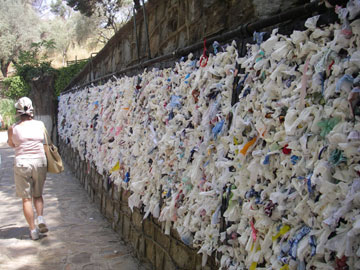 One of the more interesting features of Mary's House is a prayer wall near the dwelling. Pilgrims come from all over the world to this place, and many offer special prayers. These prayers are written on small pieces of paper that are attached to the wall. One of the more interesting features of Mary's House is a prayer wall near the dwelling. Pilgrims come from all over the world to this place, and many offer special prayers. These prayers are written on small pieces of paper that are attached to the wall.
As it turns out, Christians are not the only ones who make pilgrimages to Mary's House. Many Muslims come as well, since they honor Mary as the mother of the prophet Jesus. For this reason, when Pope Benedict XVI visited Mary's House, he said, "From here in Ephesus, a city blessed by the presence of Mary Most Holy — who we know is loved and venerated also by Muslims - let us lift up to the Lord a special prayer for peace between peoples."
Did Mary actually live near Ephesus? Was this her final dwelling? I don't believe we have adequate historical grounds for deciding the question either way. But if you're ever in Ephesus, it's worth a trip up to Mary's House, especially if it's a hot day and you'd like some moments of relief.
|

